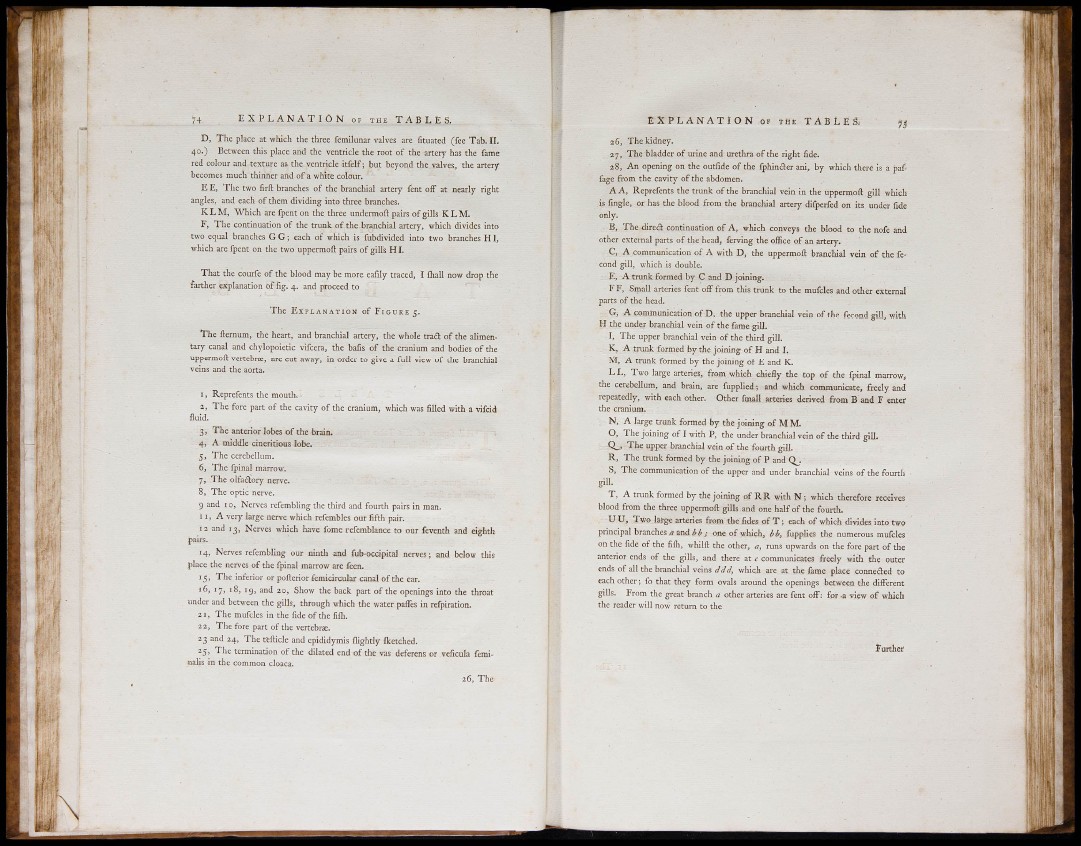
!
P
i
If
ttx.:
74 E X P L A N A T I O N OF THE T A B L E S .
D , The place at which the three femilanar valves are fituated (fee Tab. II.
40.) Between this place and the ventricle the root of the artery has the fame
red colour and texture as the ventricle itfelf; but beyond the valves, the artery
becomes much thinner and of a white colour.
E E, The two firft branches of the branchial artery fent off at nearly right
angles, and each of them dividing into three branches.
K L M, M^hich are fpent on the three undcrmoil: pairs of gills K L M.
F, The continuation of the trunk of the branchial artery, which divides into
two equal branches G G ; each of which is fubdivided into two branches H I,
which are fpent on the two uppermofl: pairs of gills H I.
That the comfe of the blood may be more eafily traced, I iliall now drop the
farther explanation of fig. 4. and proceed to
T h e EX P L A N A T I O N of FI G U R E 5.
T h e ilernum, the heart, and branchial artery, the whole trad of the alimentary
canal and chylopoietic vifcera, the bafis of the cranium and bodies of tlie
uppermoft vertebra, are cat away, in order to give a ful l view of the branchial
veins and tlie aorta.
1 , Reprefents the mouth.
2, The fore part of the cavity of the cranium^ which was filled with a vifcid
fluid.
3, The anterior lobes of the brain.
4^ A middle cineritious lobe.
5 , The cerebellum.
6, The fpinal marrow.
7 , The olfadory nerve.
8, The optic nerve.
9 and 10, Nerves refembling the third and fourth pairs in man.
1 1 , A very large nerve which refembles our fifth pair.
12 and 13, Nerves which have fome rcfemblance to our feventh and eighth
pairs.
14, Nerves refembling our ninth and fub-occipitai nerves; and below this
place the nerves of the fpinal marrow are feen.
15, The inferior or poflerior femicircular canal of the ear.
16, 17, 18, I g , and 20, Show the back part of the openings into the throat
under and between the gills, through -which the water paffes in refpiration.
21, The mufcles in the fide of the fifli.
22, The fore part of the vertebrae.
2 ¡ and 24, The refticle and epididymis ¡lightly (ketched.
25, The termination of the dilated end of the vas deferens or veficula feminalis
in the common cloaca.
26, The
E X P L A N A T I O N OF TME T A B L E D »
26, The kidney.
27, The bladder of urine and urethra of the right fide.
28, An opening on the outfide of the fphincler ani, by which there is a paffage
from the cavity of the abdomen.
A A , Reprefents the trunk of the branchial vein in the uppermoft gill which
is lingle. or has the blood from the branchial artery difperfed on its under fide
only.
B, The dirca continuation of A , which conveys the blood to the nofe and
other external parts of the head, ferving the office o f an artery.
C , A communication of A with D, the uppermoft branchial vein of the fécond
gill, which is double.
E , A trunk formed by C and D joining.
r F, Small arteries fcnt off from this trunk to the mufcles and other external
parts of the head.
G, A communication of D, the upper branchial vein of the fécond gill, with
H the under branchial vein of the fame gill.
I, The upper branchial vein of the third gill.
K , A trunk formed by the joining of H and I.
M, A trunk formed by the joining of E and K.
L L, Two large arteries, from which chiefly the top of the fpinal marrow,
the cerebellum, and brain, are fupplied ; and which conununicate, freely and
repeatedly, with each other. Other fmall arteries derived from B and P enter
the cranium.
N , A large trunk formed by the joining of M M.
O , The joining of I with P, the under branchial vein o f the third gill.
Q^, The upper branchial vein of the fourth gill.
R , The trunk formed by the joining of P and
S, The communication of the upper and under branchial veins of the fourth
gill.
T , A trunk formed by the joining of R R with N ; which therefore receives
blood from the three uppermoft gills and one half of the fourth.
U U , Two large arteries from the fides o f T ; each of which divides into two
principal branches and ^ i ; one of which, i i , fupplies the numerous mufcles
on the fide of the fifli, whilft the other, a, runs upwards on the fore part of the
anterior ends of the gills, and there at c communicates freely with the outer
ends of all the branchial veins ddd, which are at tlie fame place conneded to
each other ; fo that they form ovals around the openings between the different
gills. From the great branch a other arteries are fent off : for -a view of which
the reader will now return to the
Further
it
i î î nL